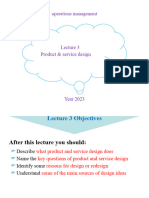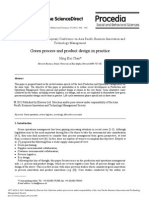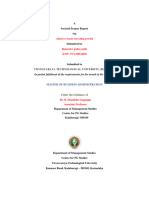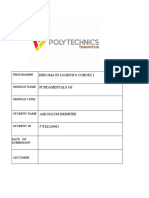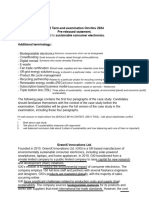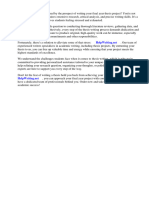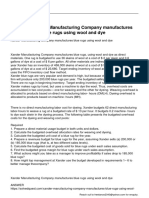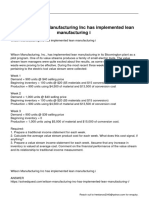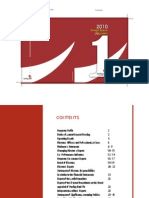1 Consider The Examples of Recycling and Refurbishing Described in
1 Consider The Examples of Recycling and Refurbishing Described in
Uploaded by
Amit PandeyCopyright:
Available Formats
1 Consider The Examples of Recycling and Refurbishing Described in
1 Consider The Examples of Recycling and Refurbishing Described in
Uploaded by
Amit PandeyOriginal Description:
Original Title
Copyright
Available Formats
Share this document
Did you find this document useful?
Is this content inappropriate?
Copyright:
Available Formats
1 Consider The Examples of Recycling and Refurbishing Described in
1 Consider The Examples of Recycling and Refurbishing Described in
Uploaded by
Amit PandeyCopyright:
Available Formats
Solved: 1 Consider the examples of recycling and
refurbishing described in
1. Consider the examples of recycling and refurbishing described in the case. Who are the
various stakeholders who benefit from these efforts? How do efforts to build sustainable supply
chains differ from simple good business practice?
2. Would Samsung have put in place the Take Back & Recycling program in a business
environment that did not emphasize sustainability? Why or why not? What about ATCLE's
refurbishing services?
3. In your opinion, will sustainability become another core measure of operations and supply
chain performance, in addition to cost, quality, delivery, and quality? Why or why not?
The path to a greener supply chain is often paved with forward looking ideas focused on
environmentally friendly manufacturing, transportation, and distribution processes. For some
companies, however, the key to jump-starting supply chain sustainability can be found in
reverse. By embracing reverse logistics strategies-including returns management, product
repair and refurbishment, recycling of goods and materials, and proper disposal of materials
from unwanted goods-companies can move the sustainability while also cutting costs and
reaping products with a longer shelf life.
One business sector that is championing these activities- and seeing the bottom-line benefits-is
the electronics industry, largely because of the skyrocketing growth in high-tech gadgets.
Thanks to ever-changing technology, top sellers such as digital cameras, cell phones, video
game systems, computers, televisions, and other electronic devices become obsolete in a few
short years-leaving electronics manufacturers to deal with mountains of unwanted product.
Recycling
For electronics manufacturers, recycling unwanted components is one key aspect of green
reverse logistics. In 2007, Samsung, a global leader in the electronics industry, began its
Recycling Direct program-partnering with take-back and recycling companies that do not
incinerate, send materials to solid waste landfills, or export toxic waste to developing countries-
and has since recycled 14 million pounds of waste from its consumer goods and IT products.
The company has established drop-off locations across all 50 states in more than 200 fixed
locations, where consumers can take unwanted electronics (both Samsung and non-Samsung
brands). "Our goal is to make it convenient for Samsung customers to recycle old TVs, phones,
camcorders, printers, notebook computers, and other electronics at no charge," explains David
Steel, senior vice president of marketing for Samsung North America. The company has also
teamed up with the U.S. Postal Service and third-party logistics company Newgistics to operate
the Samsung Take Back & Recycling program, which enables consumers to recycle used
printer cartridges. Using a prepaid Smart Label, customers can return old printer cartridges to
Samsung by simply dropping them in any mailbox. Through this program, Samsung ensures
that empty cartridges are safely reprocessed into their major usable component materials
Reach out to freelance2040@yahoo.com for enquiry.
(including plastics, metals, and packaging materials), and then it makes those reprocessed
materials available for reuse in new manufacturing for a range of products.
Refurbishing
When a consumer returns an electronics product because it is outdated or not functioning
properly, they don't likely give much thought to what happens next. But what happens next is at
the heart of business for companies such as ATC Logistics and Electronics (ATCLE), which
performs asset recovery, repair, and refurbishing services. Brian Morris, director of engineering
for this Texas-based 3PL, gave a detailed explanation of the process involved in giving a
returned product a new life:
When we receive returns from customers, we do a test inspection to find out how many faults
the product has. If there is nothing wrong with it, we can repackage it for sale. If it's a faulty
product, we identify the failure and determine what it takes to repair or refurbish that product.
ANSWER
https://solvedquest.com/1-consider-the-examples-of-recycling-and-refurbishing-described-in/
Reach out to freelance2040@yahoo.com for enquiry.
Powered by TCPDF (www.tcpdf.org)
You might also like
- Total Quality Control - Armand V. Feigenbaum. 1983 PDFDocument871 pagesTotal Quality Control - Armand V. Feigenbaum. 1983 PDFAbraham Vallejos92% (38)
- Nostalgia Marketing Rekindling The Past To Influence Consumer Choices 3031215451 9783031215452Document166 pagesNostalgia Marketing Rekindling The Past To Influence Consumer Choices 3031215451 9783031215452k61.2212585021No ratings yet
- Your Company Is Considering Investing in Its Own Transport FleetDocument2 pagesYour Company Is Considering Investing in Its Own Transport FleetAmit Pandey0% (1)
- Yummi Lik Makes Really Big Lollipops in Two Sizes Large andDocument2 pagesYummi Lik Makes Really Big Lollipops in Two Sizes Large andAmit Pandey0% (1)
- Marketing C212 - J.mcclendonDocument17 pagesMarketing C212 - J.mcclendonJacqueline McClendon-Adams100% (2)
- Company ProfileDocument18 pagesCompany ProfileI-Combytes CorporationNo ratings yet
- Lifecycle Assessment of The Environmental Benefits of Remanufactured Telecommunications Product Within A "Green" Supply ChainDocument6 pagesLifecycle Assessment of The Environmental Benefits of Remanufactured Telecommunications Product Within A "Green" Supply ChainAlexander BellNo ratings yet
- You Are Employed As The Assistant Accountant in Your CompanyDocument1 pageYou Are Employed As The Assistant Accountant in Your CompanyAmit PandeyNo ratings yet
- X PLC Manufactures Product X Using Three Different Raw MaterialsDocument2 pagesX PLC Manufactures Product X Using Three Different Raw MaterialsAmit Pandey100% (1)
- Wise Company Began Operations at The Beginning of 2018 TheDocument2 pagesWise Company Began Operations at The Beginning of 2018 TheAmit PandeyNo ratings yet
- Warren S Sporting Goods Store Sells A Variety of Sporting GoodsDocument2 pagesWarren S Sporting Goods Store Sells A Variety of Sporting GoodsAmit PandeyNo ratings yet
- Winter Sports Manufacture Snowboards Its Cost of Making 2 100 BindingsDocument1 pageWinter Sports Manufacture Snowboards Its Cost of Making 2 100 BindingsAmit PandeyNo ratings yet
- When The Fraud at Pepsico Occurred The Company Had FiveDocument2 pagesWhen The Fraud at Pepsico Occurred The Company Had FiveAmit PandeyNo ratings yet
- Course Book TAKTKTDocument201 pagesCourse Book TAKTKTHạ Mộc100% (1)
- Viability of The Proposed SolutionDocument3 pagesViability of The Proposed Solutionapi-242778836No ratings yet
- Evolution of Closed-Loop Supply ChiansDocument5 pagesEvolution of Closed-Loop Supply ChiansAnnyatamaBhowmikNo ratings yet
- Circularity Indicator Case StudiesDocument8 pagesCircularity Indicator Case Studiesmarcus salaNo ratings yet
- Circularity Indicators - Non Technical Case Studies - May2015 PDFDocument8 pagesCircularity Indicators - Non Technical Case Studies - May2015 PDFKoushik PonnuruNo ratings yet
- Assignment 1Document9 pagesAssignment 1api-265324689No ratings yet
- L&T ChallengesDocument82 pagesL&T Challengeskongunadusih23No ratings yet
- Reverse Logistics - WikipediaDocument7 pagesReverse Logistics - WikipediaSTEPHIN GEORGE KIMSNo ratings yet
- E-Business and Circular Supply ChainsDocument24 pagesE-Business and Circular Supply ChainsNipun BansalNo ratings yet
- National and International Market For Recycling MachinesDocument8 pagesNational and International Market For Recycling MachinesFatima ZafarNo ratings yet
- Design ViabilityDocument5 pagesDesign Viabilityapi-299000804No ratings yet
- Part F Design ViablityDocument3 pagesPart F Design Viablityapi-319498370No ratings yet
- Factors_Affecting_Behaviours_of_Returning_E-Waste_Document11 pagesFactors_Affecting_Behaviours_of_Returning_E-Waste_dingsng117No ratings yet
- Semiconductor Safety ManagementDocument6 pagesSemiconductor Safety ManagementDeign SeseNo ratings yet
- f1 1 Design ViablityDocument4 pagesf1 1 Design Viablityapi-264098585No ratings yet
- The Implementation of Green Supply Chain Management Practices in Electronics IndustryDocument6 pagesThe Implementation of Green Supply Chain Management Practices in Electronics Industrylee ho kwangNo ratings yet
- MANGUIAT - AIS3C - Case Analysis - Global EthicsDocument3 pagesMANGUIAT - AIS3C - Case Analysis - Global EthicsKlarence ManguiatNo ratings yet
- P PDFDocument19 pagesP PDFPayal AggarwalNo ratings yet
- The Evolution of Closed-Loop Supply Chain Research: V. Daniel R. Guide Jr. Luk N. Van WassenhoveDocument9 pagesThe Evolution of Closed-Loop Supply Chain Research: V. Daniel R. Guide Jr. Luk N. Van Wassenhovershan26No ratings yet
- Reverse LogitsicsDocument9 pagesReverse Logitsicsmerlin masterchiefNo ratings yet
- Issues Product DesignDocument19 pagesIssues Product DesignFarah AbdillahNo ratings yet
- f1 1 Design ViablityDocument3 pagesf1 1 Design Viablityapi-301407444No ratings yet
- OM Lecture 3 Product & Service DesignDocument25 pagesOM Lecture 3 Product & Service DesignDawit HusseinNo ratings yet
- OM Lecture 3 Product and Service DesignDocument26 pagesOM Lecture 3 Product and Service DesignDawit HusseinNo ratings yet
- Green Process and Product Design in PracticeDocument5 pagesGreen Process and Product Design in PracticekacangdeleNo ratings yet
- Chapter-1-Solutions-Oscm (1) - Đã G PDocument102 pagesChapter-1-Solutions-Oscm (1) - Đã G Pminhthu2902studyNo ratings yet
- Design ViabilityDocument3 pagesDesign Viabilityapi-309151760No ratings yet
- Activity4 Product and Service DesignDocument11 pagesActivity4 Product and Service Designnisperos.majanelleNo ratings yet
- Technology Ready or Not Here Comes SustainabilityDocument9 pagesTechnology Ready or Not Here Comes SustainabilityDisha MathurNo ratings yet
- RREUSE Case Studies On Reparability - FinalDocument14 pagesRREUSE Case Studies On Reparability - FinalAAANo ratings yet
- Design For Manufacture and Assembly Luggage Trolley DesignDocument37 pagesDesign For Manufacture and Assembly Luggage Trolley DesignNeville Lawless100% (6)
- GC Unit4Document12 pagesGC Unit4RishabNo ratings yet
- Green Supply Chain ManagementDocument12 pagesGreen Supply Chain ManagementSofshawon2820No ratings yet
- GSMC520 Unit 1 Learning Activity Solutions: InstructionsDocument9 pagesGSMC520 Unit 1 Learning Activity Solutions: InstructionsZeah LimNo ratings yet
- Attero - E - (AutoRecovered) - New Saved PDFDocument10 pagesAttero - E - (AutoRecovered) - New Saved PDFRamesh PatilNo ratings yet
- Winstel Quentin 11271262Document10 pagesWinstel Quentin 11271262Le Penseur WNo ratings yet
- Product and Service DesignDocument6 pagesProduct and Service Designjenalyn1206No ratings yet
- The Impact of Green Computing in The Industrial ManagementDocument7 pagesThe Impact of Green Computing in The Industrial Managementdinesh198633No ratings yet
- ASGN 401 NewDocument22 pagesASGN 401 NewmanuNo ratings yet
- A Study On Consumer Behaviour About Remanufactured Electronic Gadgets in Indian MarketDocument10 pagesA Study On Consumer Behaviour About Remanufactured Electronic Gadgets in Indian MarketarcherselevatorsNo ratings yet
- Part 4 - Sundin and Bras 2005 (1)Document13 pagesPart 4 - Sundin and Bras 2005 (1)arh200014No ratings yet
- MB0044 Production & Operations Management (Semester-II) Book ID: B1133 Assignment Set - IDocument10 pagesMB0044 Production & Operations Management (Semester-II) Book ID: B1133 Assignment Set - IpriamrahulNo ratings yet
- LogisticsDocument7 pagesLogisticsPrishneeBNo ratings yet
- BM - NovTEE 2024 - P1 Pre-Released StatementDocument3 pagesBM - NovTEE 2024 - P1 Pre-Released StatementKrrish GandhiNo ratings yet
- Viability of The Proposed SolutionDocument3 pagesViability of The Proposed Solutionapi-733826368No ratings yet
- Dell DfE Survey PaperDocument4 pagesDell DfE Survey Paperwb22f014aNo ratings yet
- Viability of The Proposed SolutionDocument3 pagesViability of The Proposed Solutionapi-723687828No ratings yet
- Example Thesis Final Year ProjectDocument5 pagesExample Thesis Final Year Projectlynakavojos3100% (2)
- Prediction of Consumer Behavior Regarding Purchasing Remanufactured Products: A Logistics Regression ModelDocument10 pagesPrediction of Consumer Behavior Regarding Purchasing Remanufactured Products: A Logistics Regression Modelhanna 90No ratings yet
- Proposal ModifiedDocument12 pagesProposal ModifiedkaranNo ratings yet
- A PSO-based Optimum Consumer Incentive Policy For WEEE Incorporating Reliability of ComponentsDocument10 pagesA PSO-based Optimum Consumer Incentive Policy For WEEE Incorporating Reliability of Componentsqjyb94x7f9No ratings yet
- Group Assessment: Task 2 - Analysis of An Interaction Design ProblemDocument6 pagesGroup Assessment: Task 2 - Analysis of An Interaction Design Problemnightchild_2No ratings yet
- Mengxun Nie SSCMDocument14 pagesMengxun Nie SSCMAnonymous kTVBUxrNo ratings yet
- Accenture Returns RepairsDocument7 pagesAccenture Returns RepairsBhairav MehtaNo ratings yet
- Operations Management & Supply Chain Case Study: ATS Synthetic & PlasticsDocument16 pagesOperations Management & Supply Chain Case Study: ATS Synthetic & PlasticsSyed Shahid SheraziNo ratings yet
- f1 1 Design Viablity 1Document4 pagesf1 1 Design Viablity 1api-271662567No ratings yet
- Digital Twins: How Engineers Can Adopt Them To Enhance PerformancesFrom EverandDigital Twins: How Engineers Can Adopt Them To Enhance PerformancesNo ratings yet
- York PLC Was Formed Three Years Ago by A GroupDocument2 pagesYork PLC Was Formed Three Years Ago by A GroupAmit PandeyNo ratings yet
- You May Refer To The Opening Story of Tony andDocument3 pagesYou May Refer To The Opening Story of Tony andAmit PandeyNo ratings yet
- You Have Recently Been Hired by Layton Motors Inc LmiDocument1 pageYou Have Recently Been Hired by Layton Motors Inc LmiAmit PandeyNo ratings yet
- Zanella S Smart Shawls Inc Is A Small Business That ZanellaDocument1 pageZanella S Smart Shawls Inc Is A Small Business That ZanellaAmit PandeyNo ratings yet
- Your Company Produces Cookies in A Two Step Process The MixingDocument1 pageYour Company Produces Cookies in A Two Step Process The MixingAmit PandeyNo ratings yet
- Xerxes Manufacturing Company Manufactures Blue Rugs Using Wool and DyeDocument2 pagesXerxes Manufacturing Company Manufactures Blue Rugs Using Wool and DyeAmit PandeyNo ratings yet
- Zits LTD Makes Two Models For Rotary Lawn Mowers TheDocument1 pageZits LTD Makes Two Models For Rotary Lawn Mowers TheAmit PandeyNo ratings yet
- Watercooler Office Supply S March 31 2016 Balance Sheet Follows The BudgetDocument2 pagesWatercooler Office Supply S March 31 2016 Balance Sheet Follows The BudgetAmit PandeyNo ratings yet
- Xander Manufacturing Company Manufactures Blue Rugs Using Wool and DyeDocument2 pagesXander Manufacturing Company Manufactures Blue Rugs Using Wool and DyeAmit PandeyNo ratings yet
- You Have Been Asked To Assist The Management of IronwoodDocument2 pagesYou Have Been Asked To Assist The Management of IronwoodAmit PandeyNo ratings yet
- Xy Limited Commenced Trading On 1 February With Fully PaidDocument2 pagesXy Limited Commenced Trading On 1 February With Fully PaidAmit Pandey100% (1)
- Williams and Dimaggio Architects Have Been Using A Simplified CostingDocument1 pageWilliams and Dimaggio Architects Have Been Using A Simplified CostingAmit PandeyNo ratings yet
- Wildride Sports Manufactures Snowboards Its Cost of Making 24 900 BindingsDocument1 pageWildride Sports Manufactures Snowboards Its Cost of Making 24 900 BindingsAmit PandeyNo ratings yet
- Wild Ride Manufactures Snowboards Its Cost of Making 1 900 BindingsDocument1 pageWild Ride Manufactures Snowboards Its Cost of Making 1 900 BindingsAmit PandeyNo ratings yet
- Wholesome and Happy Foods Is A Farm To Family Grocery Store LocatedDocument1 pageWholesome and Happy Foods Is A Farm To Family Grocery Store LocatedAmit PandeyNo ratings yet
- West Coast Designs Produces Three Products Super Deluxe and GDocument1 pageWest Coast Designs Produces Three Products Super Deluxe and GAmit PandeyNo ratings yet
- Visit WWW Pearsonhighered Com Horngren To View A Link To Starbucks Corporation 2011Document1 pageVisit WWW Pearsonhighered Com Horngren To View A Link To Starbucks Corporation 2011Amit PandeyNo ratings yet
- Warren LTD Is To Produce A New Product in ADocument2 pagesWarren LTD Is To Produce A New Product in AAmit PandeyNo ratings yet
- Wilson Manufacturing Inc Has Implemented Lean Manufacturing IDocument1 pageWilson Manufacturing Inc Has Implemented Lean Manufacturing IAmit PandeyNo ratings yet
- Wheeler Food in Ashland Kentucky Manufactures and Markets Snack FoodsDocument1 pageWheeler Food in Ashland Kentucky Manufactures and Markets Snack FoodsAmit PandeyNo ratings yet
- Vihn LTD S Ledger Showed A Cash Balance of 22 680 OnDocument2 pagesVihn LTD S Ledger Showed A Cash Balance of 22 680 OnAmit PandeyNo ratings yet
- Vassar Corp Has Incurred Substantial Losses For Several Years ADocument2 pagesVassar Corp Has Incurred Substantial Losses For Several Years AAmit PandeyNo ratings yet
- Print - Udyam Registration CertificateDocument1 pagePrint - Udyam Registration CertificatengonizamiNo ratings yet
- Notice Inviting Bid: Signature Not VerifiedDocument1 pageNotice Inviting Bid: Signature Not VerifiedBhavesh Patel100% (1)
- Bsiness Plan YAGNACHEWDocument19 pagesBsiness Plan YAGNACHEWBirhanu Zeleke100% (1)
- Paper Mmep ScorDocument7 pagesPaper Mmep ScorElisa KusriniNo ratings yet
- 19 02657 Rem-Sq Das 4-1 Phase 1 Masterplan Part1.pdf-3135156Document18 pages19 02657 Rem-Sq Das 4-1 Phase 1 Masterplan Part1.pdf-3135156Abhi ChavanNo ratings yet
- Management Advisory ServicesDocument4 pagesManagement Advisory ServicesYaj CruzadaNo ratings yet
- Copyright InfringementDocument4 pagesCopyright InfringementVaibhavi KathareNo ratings yet
- A2ZworksheetsWorksheet of Hindi Grammar - Sangya Worksheet-09-Hindi-LanguageDocument1 pageA2ZworksheetsWorksheet of Hindi Grammar - Sangya Worksheet-09-Hindi-Languagesindu binuNo ratings yet
- Bachelor of Arts in Law CVDocument2 pagesBachelor of Arts in Law CVانجینئر بلاول شمیرNo ratings yet
- Retail Thesis PDFDocument6 pagesRetail Thesis PDFWriteMyCollegePaperSingapore100% (2)
- PRSN CNMDocument77 pagesPRSN CNMBradGourdoNo ratings yet
- Invoice #1475: PT. EIKON TechnologyDocument1 pageInvoice #1475: PT. EIKON TechnologyMochamad NurNo ratings yet
- Payment Channels Bayad Center PDFDocument116 pagesPayment Channels Bayad Center PDFElijah NonanNo ratings yet
- Coconut Mango Basil Chia Pudding Report (CDIO)Document14 pagesCoconut Mango Basil Chia Pudding Report (CDIO)Dorothy LimNo ratings yet
- Intro. To Aerospace Eng. Design: - Design For Manufacturing in Aircraft IndustryDocument28 pagesIntro. To Aerospace Eng. Design: - Design For Manufacturing in Aircraft IndustryAuston MatthewsNo ratings yet
- Supplier Risk Assessment: 3 - Leading Questions 0 Poor 1 Average 2 - GoodDocument2 pagesSupplier Risk Assessment: 3 - Leading Questions 0 Poor 1 Average 2 - GoodAnthonyNo ratings yet
- Scan 0008Document3 pagesScan 0008S DasNo ratings yet
- Methodological Guide For Developing Producer Price Indices For ServicesDocument149 pagesMethodological Guide For Developing Producer Price Indices For ServicesWardani ArsyadNo ratings yet
- PNB Versus CabansagDocument2 pagesPNB Versus CabansagCeresjudicataNo ratings yet
- Zambia Sugar PDFDocument7 pagesZambia Sugar PDFNicholas M BandaNo ratings yet
- Certificado Tuberia PealpeDocument2 pagesCertificado Tuberia Pealpefalr2013No ratings yet
- VDA 6 - 3 Check ListDocument4 pagesVDA 6 - 3 Check ListKhan SattrakulvongNo ratings yet
- Sterling Bank PLC 2010 Annual Report & AccountsDocument125 pagesSterling Bank PLC 2010 Annual Report & AccountsSterling Bank PLC100% (1)
- SMAC Deep DiveDocument53 pagesSMAC Deep DivePBM paneerbuttermasalaNo ratings yet
- Case Study in Entrepreneurship MindDocument1 pageCase Study in Entrepreneurship MindIvan MallariNo ratings yet
- Technical Writing 5Document19 pagesTechnical Writing 5Lady Ann GarciaNo ratings yet
- Pom QP With AnswerDocument8 pagesPom QP With AnswersaiNo ratings yet



































